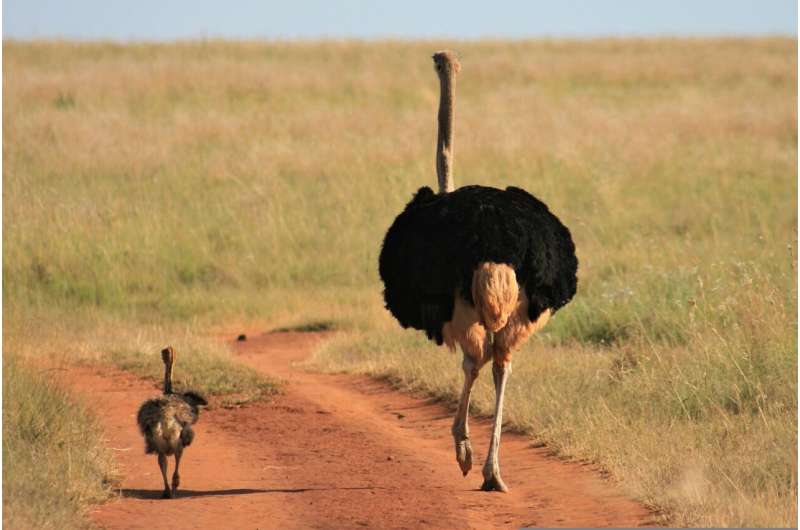Optimal breeding group sizes differ by sex in cooperative animals

The evolutionary pros and cons of group living vary for males and females, according to a study of ostriches reported today in eLife.
The findings help explain why the size of ostrich groups living can vary so widely in the wild, showing that the optimal size of a group depends on the balance of males and females within it.
Like humans, ostriches cope with the challenges of parenthood by joining together to take care of their offspring. Groups breed in a communal nest and individuals take it in turn to incubate eggs. However, this cooperative breeding is not without its costs, because there can be intense competition over mating and who's eggs get incubated.
"The competing forces of competition and cooperation are expected to result in there being an optimal group size in nature," explains lead author Julian Melgar, a postdoctoral researcher at Lund University, Sweden. "But in the wild, groups are highly variable in size and it is not clear why."
A common explanation is that group sizes change with fluctuations in ecological conditions, but this does not explain why groups with different compositions live under similar conditions.
"We set out to study the costs and benefits of group size under consistent ecological conditions, to separate out the effect of individual differences from group attributes on reproductive success and disentangle how competition and cooperation change with group size," explains Melgar.
At the start of each breeding season in May across eight years, experimental groups of ostriches were established by placing different numbers of males and females in large enclosures in Klein Karoo, South Africa. Groups consisted of one or three males and one, three, four or six females, similar to the range of group sizes seen in the wild. During part of the breeding season, the cooperative incubation behavior was prevented by temporarily removing eggs. The impact of the number of males and females in groups, and cooperation over incubation on reproductive success was measured.
The study revealed three main findings. First, there are multiple optimal group sizes for females as their reproductive success depends on cooperative offspring care provided by both male and female ostriches. By contrast, the second finding was that males have a single optimal group size that is defined by the high costs of competing with other males and the low benefits of cooperative care.
Third, intermediate-sized groups were not optimal for reproductive success for either males or females. This was because of conflict over the timing of mating and offspring care. In intermediate-size groups, interruptions to incubation occurred when males mated with incubating females, causing damage to eggs. These differences in the way male and female reproductive success is maximized can help explain why group sizes vary so much in nature.
"Ecological conditions, breeder quality and relatedness are often used to explain variation in the size of cooperative breeding groups, but our results demonstrate that this variation arises independently of these factors," concludes senior author Charlie Cornwallis, Senior Lecturer at Lund University, Sweden.
"The counteracting forces of cooperation and competition can generate divergent reproductive interests between males and females and increase the range of social conditions where reproductive success is highest. Our findings will help us understand why cooperative societies are the way they are, and may aid conservation work and animal breeding programs by showing how different social pressures influence reproduction."
More information: Julian Melgar et al, Experimental evidence that group size generates divergent benefits of cooperative breeding for male and female ostriches, eLife (2022). DOI: 10.7554/eLife.77170
Journal information: eLife
Provided by eLife



















